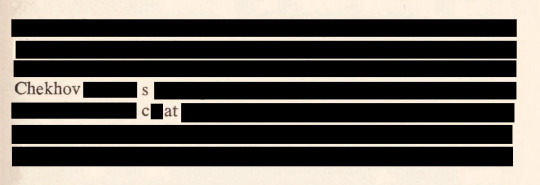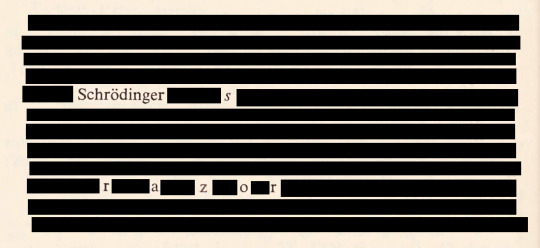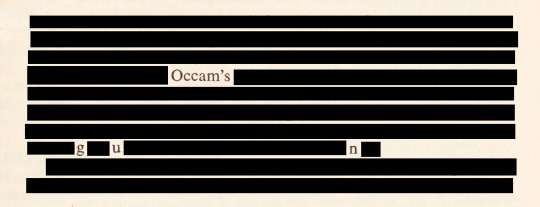#Shrodinger's razor
Explore tagged Tumblr posts
Text

(Transcript for those of you with screen readers bcuz I couldn’t figure out how to attach it to the image itself on mobile for some reason)
Person 1:
Chekov's Cat: if you see a cat in the first act, it will probably be relevant later. (example: Alien)
Shrodinger's razor: an unopened box may or may not contain the solution to the story; there's no way to know without opening it. (example: Monk)
Occam's gun: the simplest way to kill off a character is to shoot them. (example: Bambi)
Person 2:
Chekov's Box: If there is a container introduced in the opening act, it will be opened later.
Schrodinger's Gun: Treat every gun as if It's loaded unless you've checked it yourself.
Occar's Cat: If you hear strange noises at night, it's probably a cat.
Person 3:
Chekhov's gun: a narrative principle that states that every element in a story must be necessary, and irrelevant elements should be removed.
Occam's razor: if you have two competing ideas to explain the same phenomenon, you should prefer the simpler one.
Shrodingers cat- a cat in a box with poison that has a 50% chance of breaking, we will not know if the cat is dead or alive until opening the box leaving the cat in a perpetual state of uncertainty
#Shrodingers cat#Occam's razor#Chekhov's gun#Occar's Cat#Schrodinger's Gun#Chekov's Box#Occam's gun#Shrodinger's razor#Chekov's Cat
14 notes
·
View notes
Text
enjoy clear skies (yes, even then)
Rating: General Audiences Archive Warning: No Archive Warnings Apply Category: M/M Fandoms: Star Wars: The Clone Wars (2008) - All Media Types, Star Wars: Clone Wars (2003) - All Media Types, Star Wars - All Media Types, Star Wars Prequel Trilogy Relationship: Alpha-17/CC-1010 | Fox Characters: Alpha-17, CC-1010 | Fox Additional Tags: Alternate Universe, Alternate Universe - Canon Divergence, Canon Divergence, Alternate Universe - Wing Fic, wing fic, Trainer Fox, Planet: Kamino, Post POW!Alpha-17, Pining, Unresolved Pining Language: English Words: 850
Summary: Kamino is 94% storm weather, 1% typhoon, and 5% calm seas. That five percent are Fox's favorite training days.
For the @cloneshiprarepair Clone Ship Rare Pair: January: Alpha-17/Fox
Bingos: @badthingshappenbingo Bad Things Happen: Damaged Wing(s) @clonefandomevents Corrie Bingo: Free Space (Wingfic) @clonefandomevents Fox Bingo: Brotherhood, Free Space (Unrequited Pining) @clonefandomevents Commando Bingo: Planet: Kamino @clonefandomevents Kamino Bingo: Free Space (Wingfic) @clonefandomevents Specialist Bingo: Trainer Fox @starwarsrarepairbingo Star Wars Rare Pair: Wings (Card 1)
Also Gun/Cat/Razor/Law Bingo, which is wholly @grackle-draws's fault: Shrodinger's Law “You can’t know that things will go wrong until they do.”









#fandoms#star wars#ptwrites#creative bingos#cloneshipping#bingo cards#clonefandomevents#starwarsrarepairs#cloneshippingrarepairs#badthingshappen
15 notes
·
View notes
Text
Shrodinger's cat: made up, impossible, essentially a joke
Chekov's gun: not real and in fact implying he had it would probably annoy him
Russel's teapot: also made up but, while improbable, technically could exist
Okham's razor: actually i don't think i needed this one
Pavlov's dog: not only is it real, there was more than one of these
Chekov's gun: we already covered this one and i said it's no--💥🔫
8 notes
·
View notes
Text
[IDs: First image is a 4x4 grid, with columns labeled Gun, Cat, Razor, Law and rows labeled Checkov's, Shrodinger's, Occam's, Murphy's. The boxes read as following.
Checkov's Gun: If a gun is introduced in the first act, it must be fired by the third.
Shrodinger's Gun: You can't know if a gun is loaded, or not, until the trigger is pulled
Occam's Gun: The simplest way to kill off a character is to shoot them
Murphy's Gun: Any gun that can go off, will go off
Checkov's Cat: If a box is introduced in the first act, a cat must sit in it by the third
Shrodinger's Cat: An unopened box may contain a dead cat, or an alive one, and you won't know until you open it
Occam's Cat: If you hear a strange noise at night, it's probably a cat
Murphy's Cat: Any box that can contain a cat, will contain a cat
Checkov's Razor: The simplest way to fire a gun is to pull the trigger
Shrodinger's Razor: An unopened box may contain the solution to your problems
Occam's Razor: The simplest explanation is probably the correct one
Murphy's Razor: Anything that can be simple, will be simple
Checkov's Law: Every gun in a play will be fired
Shrodinger's Law: You can't know that things will go wrong, until they do
Occam's Law: Everything that can be explained, will be explained
Murphy's Law: Anything that can go wrong, will go wrong
Small text in the corner reads "Revx, MrBigBux, Halesnail, Venort. ATP". End first ID.
Second image is the same 4x4 grid, with columns labeled Gun, Cat, Razor, Law and rows labeled Checkov's, Shrodinger's, Occam's, Murphy's. This time it is on a dark background with similar text being consistent colors across the boxes, showing how the columns and rows interact. The boxes read as following.
Checkov's Gun: A gun introduced in the first act must be fired by the third act.
Shrodinger's Gun: A gun is both empty and loaded until fired
Occam's Gun: The simplest gun is usually the one to fire.
Murphy's Gun: Any gun that can be fired, will be fired.
Checkov's Cat: A dead cat introduced in the first act must be alive by the third act.
Shrodinger's Cat: A box contains both a dead and alive cat until opened.
Occam's Cat: The simplest cat is usually in a box.
Murphy's Cat: Any cat that can die, will die.
Checkov's Razor: An explanation introduced in the first act must be correct by the third act.
Shrodinger's Razor: An explanation contains both facts and nonsense until proven.
Occam's Razor: The simplest explanation is usually the correct one.
Murphy's Razor: Any explaination that can be correct, will be correct.
Checkov's Law: Anything introduced in the first act must go wrong by the third act.
Shrodinger's Law: Anything has both gone wrong and gone right until it happens.
Occam's Law: Any explanation is usually wrong.
Murphy's Law: Anything that can go wrong, will go wrong.
End ID.]

68K notes
·
View notes
Note
Okay the tags of ur one recent post has me thinking what WAS marvus doing in the teal/jade bathroom?? 🤔 Was he just hanging out? Was he hiding from zebruh after passing through the blue car lol. Was he hooking up? 👀 We may never know 😔
Occam's razor: maybe the jade / teal car is the only one with a bathroom. I didn't see one on any of the other cars. Plus the idea of Marvus understanding the bathroom as a liminal space that only exists as a plot device is really tickling my funny bone. He's sending snaps to MSPAR that are absolutely incomprehensible. "check it babe: chillin hard in shrodinger's shitter xo)"
#marvus#marvus xoloto#asks#silas.txt#god now that i typed that last paragraph i'm all fucked up about act 2 marv pining for his buddy :(#do u think marvus feels abandoned?? i'll have to explore this as soon as i can
143 notes
·
View notes
Text
murphy's razor: the first action you take (the one youre hoping will work first try) can and will go wrong and only through trial and error will you achieve your goal
shrodinger's razor: you don't know whether the first solution will work until you try
occam's sword: the easiest solution is stabbing shit (usually works)
9 notes
·
View notes
Text
Mix up for writing prompts!
Chekov's Razor:
If you've already introduced a plot element that works for this situation, and adding a new one won't add anything else, use what you've got! (an already existing shady organization can do your murder, you don't need to make up a new one!)
Occam's Cat:
If you're trying to figure out which way to go, with a plotline or character arc, it's okay to go with what you feel most comfortable to write(don't burn yourself up trying to come up with something so complex your reader can't guess it, or is totally unique[ It's fun to figure out plot points by piecing together clues, and nothing is totally unique except each of us! ] when you'd be happier writing and most people would be happier reading what you're happy writing! )
Shrodinger's Gun:
Just because you created a cool power/ weapon/ space station doesn't mean that it HAS to be used in the final conclusion, but it doesn't mean it's not cool to USE! (I'M LOOKING AT YOU DBZ!, and the inverse is the "WHY DO THEY NEVER USE THAT ONE POWER THAT WOULD BE PERFECT HERE!")
These are not laws, or suggestions. I'm not a lawyer, I never even played one on tv!
But they might help you on your next campaign!



imagination (1963) - harold ordway rugg
"chekhovs cat / schrödingers razor / occams gun"
91K notes
·
View notes
Text
Occam's Gun: the best tool is the one that gets the job done the fastest Chekov's Razor: a simple explanation introduced in the first act must be relevant to the third Shrodinger's Gun: a gun is both loaded and unloaded until it is fired Chekov's Cat: a cat that's alive in the first act must be dead by the third, and vice-versa Murphy's Cat: anything the cat can fuck up, it will Murphy's Cat's Gun: wait shit does that cat have a gun?? oh n
5 notes
·
View notes
Photo
Schrodinger's-
Gun: The gun is fired simultaneously in the first and third acts. Dog: The dog is both salivating and not salivating Razor: The head is both shaved and not shaved Law: The amount of transistors in a microchip is both halved and doubled every two years Monster: Frankenstein is both the doctor and the monster World: The public access television show is both cancelled and not cancelled Believe it or not!: The book is filled with incredible and boring facts about the world.
___’s cat
Chekhov: If you see a cat mounted on the wall in the first act it must be in a box by the third act Pavlov: He rang a bell at boxing time, causing it to die and be alive at the same time Occam: The simplest solution is to look in the box Moore’s: The number of cats in a box doubles every two years Frankenstien’s: Actually, Shrodinger was the cat Wayne’s: He must save his public access cat Ripley: A box filled with incredible cats

i am not taking questions at this time
83K notes
·
View notes